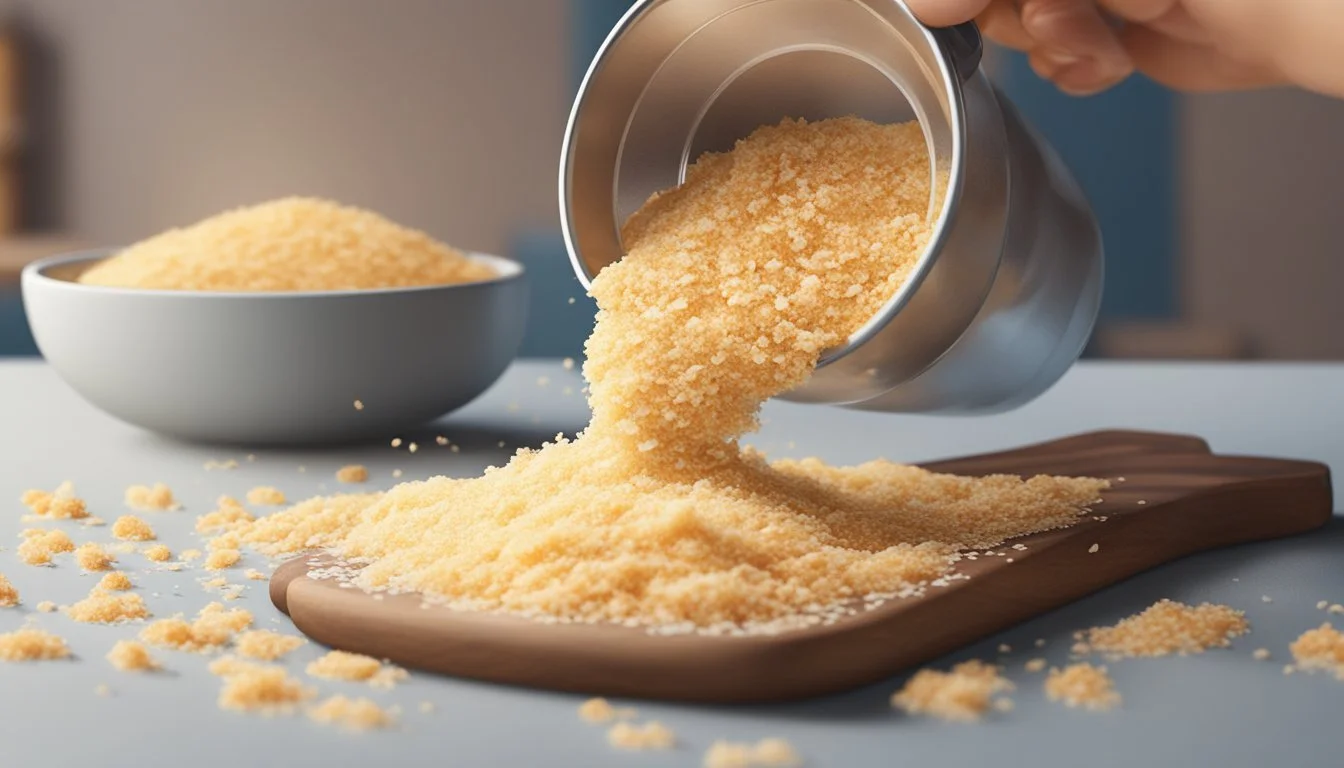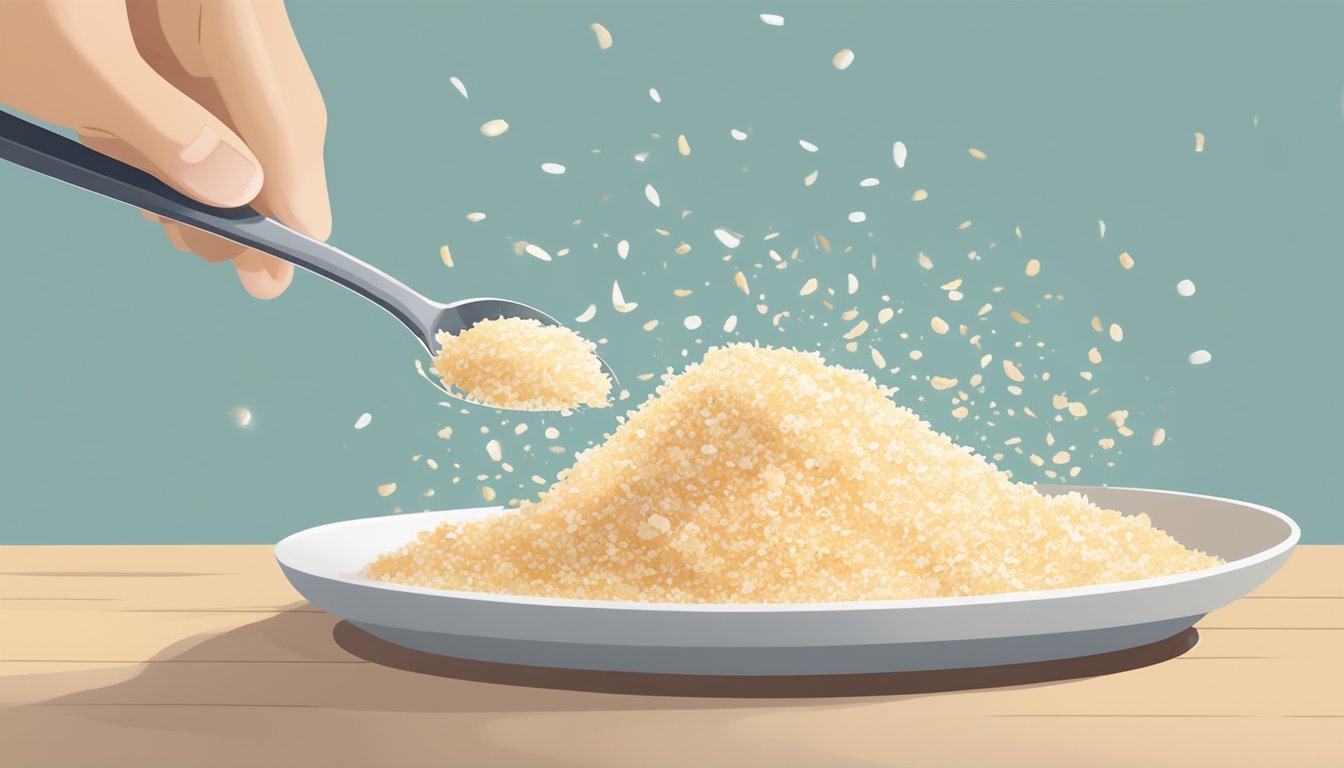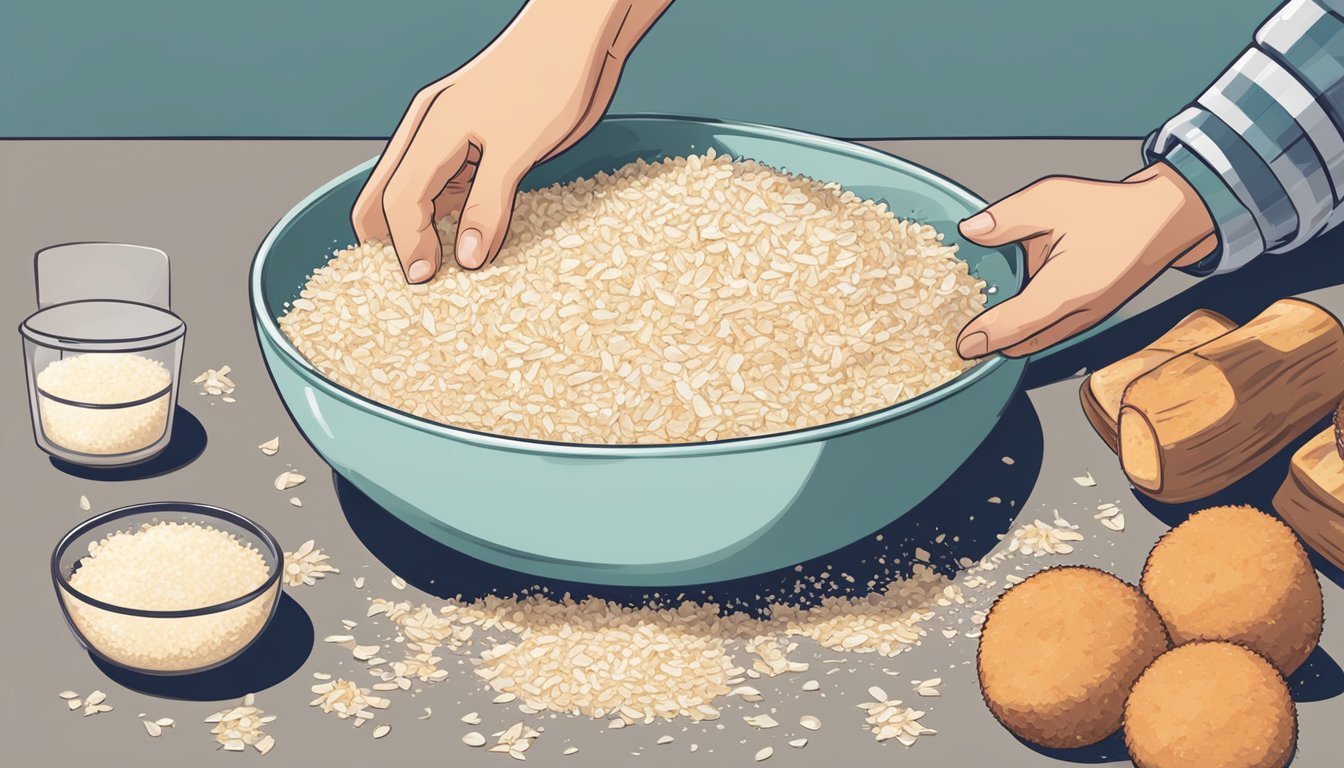How to Substitute Unsweetened Coconut Flakes for Breadcrumbs
A Simple Guide
Unsweetened coconut flakes offer a unique and flavorful alternative to traditional breadcrumbs in many recipes. When a dish calls for breadcrumbs to add texture or bulk, coconut flakes stand as an excellent grain-free option. As they are versatile and readily available, coconut flakes can be seamlessly integrated into a variety of dishes, from desserts and baked goods to meatballs and coatings for fried foods.
For those who are either allergic to traditional breadcrumbs or simply looking for a way to infuse a tropical flair into their cooking, unsweetened coconut flakes provide an ample solution. They bring a slight sweetness and a distinct coconut profile that can elevate the flavor complexity of a dish. The key to successfully using coconut flakes as a substitute is understanding the differences in moisture content and texture, as these aspects can affect the outcome of the recipe.
When replacing breadcrumbs with coconut flakes, it is essential to consider the texture and binding properties that breadcrumbs typically provide. Coconut flakes may result in a different consistency, so adjusting the quantity to suit the desired outcome of the recipe is advised. They work particularly well in recipes where a slight sweetness is complementary, and can also be toasted for a deeper flavor and added crunch, emulating the textural contribution that breadcrumbs would normally offer.
Understanding Breadcrumbs and Their Role in Cooking
Breadcrumbs serve as a versatile ingredient in the kitchen, primarily used for coating and binding, and come in various forms to accommodate different dietary needs.
Functionality of Breadcrumbs in Recipes
Breadcrumbs are a staple in many recipes due to their ability to add texture and flavor. They coat foods, creating a crispy exterior when fried or baked. As a binder, breadcrumbs help ingredients stick together, which is essential in dishes like meatballs or veggie burgers.
Common Types of Breadcrumbs
Panko Breadcrumbs: These Japanese breadcrumbs are larger and lighter, providing a distinctively crispy coating.
Homemade Breadcrumbs: Produced from oven-dried or stale bread (What wine goes well with bread?), these are easily customizable for texture.
Dried Bread Crumbs: Store-bought versions, typically finely ground for a consistent coating.
Breadcrumb Varieties and Dietary Considerations
For those with dietary restrictions, breadcrumb alternatives cater to various needs:
Gluten-Free: Made from gluten-free bread, providing the same utility without the gluten.
Low-Carb/Paleo: Options like crushed nuts or unsweetened coconut flakes substitute conventional breadcrumbs for those on low-carb or paleo diets.
Vegan: Vegan breadcrumbs are available, ensuring no animal products are used in the binding or coating processes.
Coconut Flakes as a Substitute
Unsweetened coconut flakes offer a unique and flavorful alternative to traditional breadcrumbs. They cater to various dietary preferences, such as gluten-free and low-carb, while providing a satisfying crunch.
Benefits of Using Unsweetened Coconut Flakes
Unsweetened coconut flakes are a health-conscious breadcrumb substitute. They are particularly suited for those following gluten-free or low-carb diets. The flakes are also high in fiber, which can add to the nutritional value of the dish. The fact that coconut flakes can be toasted to enhance their flavor profile makes them a versatile choice in the kitchen.
Flavor and Texture Profile of Coconut Flakes
Unsweetened coconut flakes impart a mild, nutty flavor distinct from the neutral taste of traditional breadcrumbs. The texture of coconut flakes is crisp and adds a satisfying crunch to dishes when used as a coating. They can enhance the overall sensory experience of the meal with their flavor and texture.
Preparation Tips for Substituting with Coconut Flakes
When substituting coconut flakes for breadcrumbs, the following tips should be considered:
Proportion: Start with a 1:1 ratio of coconut flakes to breadcrumbs and adjust based on personal preference.
Moisture: Coconut flakes absorb less moisture than breadcrumbs. It may be necessary to reduce other wet ingredients slightly to achieve the desired consistency.
Toasting: For a deeper flavor and extra crunch, toast the coconut flakes in a dry skillet over medium heat until golden, stirring frequently to prevent burning.
Adaptations for Specific Dishes
Substituting unsweetened coconut flakes for breadcrumbs provides a unique taste and texture. This section highlights how to effectively use coconut flakes across a variety of dishes, ensuring that they complement the main ingredients without overwhelming them.
Incorporating Coconut Flakes in Meat Dishes
For meatballs and meatloaf, unsweetened coconut flakes can be used as a one-to-one replacement for breadcrumbs. They not only bind the mixture but also add a subtle, nutty flavor. It's important to pulse the coconut flakes in a food processor to mimic the fine texture of breadcrumbs before mixing them with the meat.
Meatballs: Mix pulsed coconut flakes with ground meat, herbs, and seasonings before shaping into balls.
Meatloaf: Combine pulsed coconut flakes with minced meat, eggs, and diced vegetables, then bake as usual.
Using Coconut Flakes in Vegetarian and Vegan Recipes
Coconut flakes are suitable for vegetarian and vegan dishes, including salads and pasta. They add a satisfying crunch when toasted and can be sprinkled over dishes to enhance their texture.
Salads: Toss toasted coconut flakes atop leafy greens for added texture.
Pasta dishes: Sprinkle them over the finished pasta for a twist on traditional parmesan.
Enhancing Seafood with Coconut Flakes
Shrimp and other seafood benefit from the addition of coconut flakes, which can be used to create a crispy coating or as a garnish.
Shrimp: For breaded shrimp, replace breadcrumbs with coconut flakes, coat the shrimp evenly, and fry until golden brown.
Salads: Enhance seafood salads by mixing in lightly toasted coconut flakes for an exotic flavor profile.
Additional Breadcrumb Alternatives
When looking for alternatives to breadcrumbs, one can find a variety of options that provide similar texture and added flavor. The following substitutes are not only resourceful but also can be tailored to fit specific dietary needs or culinary desires.
Nuts and Seeds as Breadcrumb Substitutes
Nuts and seeds offer an excellent crunch and nutritional value when replacing breadcrumbs. Common varieties used include:
Almonds: Finely ground or slivered almonds add a nutty flavor.
Chia Seeds and Flax Seeds: Ideal for binding, they become gelatinous when soaked.
One can use these substitutes in a 1:1 ratio with breadcrumbs for coating or as a filler.
Utilizing Grains and Cereals for Texture
Grains and cereals can replicate the desired consistency of breadcrumbs in various dishes. Examples include:
Rolled Oats: They can replace breadcrumbs to provide texture in meatloaves or burgers.
Cooked Quinoa: A nutritious stand-in, quinoa brings a unique texture suitable for binding.
Cereal: Crushed cornflakes or rice krispies serve well for a crispy coating.
While grains and cereals cater to different cooking needs, one should consider the unique properties they bring to the dish, such as moisture content and cooking times.
Cheese and Herbs for Flavorful Crusts
Parmesan cheese, combined with herbs, can create flavorful crusts on baked or fried dishes. Consider using:
Parmesan Cheese: Offers a savory depth when mixed with other substitutes or used alone.
Herbs: Fresh or dried herbs like parsley, oregano, or basil can be added for enhanced flavor.
Cheese should be used sparingly to prevent overshadowing the primary flavors of the dish.
Processed Snacks: A Crunchy Alternative
Processed snacks provide a familiar and satisfying crunch as a breadcrumb replacement. They include:
Crushed Crackers: Commonly used for their salty and crispy texture.
Chips and Pretzels: Potato chips, tortilla chips, or pretzels, crushed finely, work as a flavorful coating.
When using processed snacks, one should be mindful of the additional salt and seasonings as they can alter the taste profile of the recipe.
Kitchen Tips and Tricks
In this section, readers will learn to craft their own breadcrumb substitutes, understand proper storage methods, and explore ways to enhance the flavor of their dishes using unsweetened coconut flakes.
Making Your Own Breadcrumb Substitutes at Home
One can easily create homemade breadcrumbs as a pantry staple by toasting unsweetened coconut flakes until they turn golden brown. This not only mimics the texture of traditional breadcrumbs but also provides a unique, tropical twist to any recipe. For homemade panko breadcrumbs, pulse the toasted flakes briefly in a food processor to achieve a coarser texture.
How to Store Breadcrumb Substitutes for Longevity
Storing your breadcrumb substitutes efficiently can maintain their freshness and usability for longer periods. Homemade breadcrumbs or coconut-flake substitutes should be stored in an airtight container in a cool, dry place. They can last up to a month when stored properly in the pantry, or even longer if kept in the refrigerator.
Boosting Flavor with Spices and Seasonings
Unsweetened coconut flakes can take on various flavor profiles when combined with different spices, herbs, or even finely chopped dried fruit. Below is a table of suggested additions to elevate your breadcrumb substitutes:
Additive Type Suggested Ingredients Spices Paprika, garlic powder, onion powder, ground black pepper Herbs Thyme, rosemary, parsley, cilantro Seeds Sesame seeds, crushed nuts for extra crunch Dried Fruit Finely minced apricots, dates, or raisins for a hint of sweetness
These ingredients should be mixed with the coconut flakes after toasting, ensuring the blend is homogeneous for the best culinary results.
Conclusion
Substituting unsweetened coconut flakes for breadcrumbs can be a creative and flavorful alternative in various recipes. When making this substitution, it is essential to consider the texture and moisture content of coconut flakes in comparison to breadcrumbs. For a crispy coating, such as that required for baked or fried foods, unsweetened coconut flakes can provide a satisfactory crunch and a unique flavor profile.
Substitution Ratios:
Equal amounts: For coatings, one can usually substitute unsweetened coconut flakes for breadcrumbs in an equal ratio.
Adjust as needed: For binding purposes in dishes like meatloaf or veggie patties, start with less coconut than breadcrumbs, and adjust for consistency.
It is important for individuals who experiment with this substitution to be aware of the distinct flavor that coconut will bring to the dish. While unsweetened coconut flakes may seamlessly integrate into sweet and savory recipes, they are best avoided in dishes where a neutral taste is desired.
For a varied texture, chefs can consider toasting the coconut flakes before use, or blend them to mimic the finer grain of breadcrumbs. Also, one must note that both coconut flakes and breadcrumbs absorb moisture differently; adjustments might be required to achieve the desired results.
In cooking ventures that embrace alteration and imagination, using unsweetened coconut flakes as a stand-in for breadcrumbs can enrich a dish with a tropical twist. Cooks are encouraged to apply their culinary expertise and personal taste preferences when pursuing this exchange to ensure their creations are as delightful as intended.






